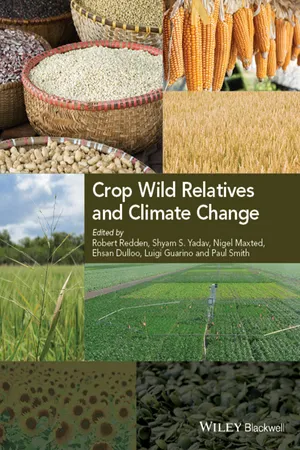
Crop Wild Relatives and Climate Change
- English
- ePUB (mobile friendly)
- Available on iOS & Android
Crop Wild Relatives and Climate Change
About This Book
Two major challenges to continued global food security are the ever increasing demand for food products, and the unprecedented abiotic stresses that crops face due to climate change.Wild relatives of domesticated crops serve as a reservoir of genetic material, with the potential to be used to develop new, improved varieties of crops. Crop Wild Relative and Climate Change integrates crop evolution, breeding technologies and biotechnologies, improved practices and sustainable approaches while exploring the role wild relatives could play inincreasingagricultural output. Crop Wild Relative and Climate Change begins with overviews of the impacts of climate change on growing environments and the challenges that agricultural production face in coming years and decades. Chapters then explore crop evolution and the potential for crop wild relatives to contribute novel genetic resources to the breeding of more resilient and productive crops. Breeding technologies and biotechnological advances that are beingused to incorporatekey genetic traits of wild relativesinto crop varieties are also covered.There is also a valuable discussion on the importance of conserving genetic resources to ensure continued successful crop production. A timely resource, Crop Wild Relative and Climate Change will be an invaluable resource for the crop science community for years to come.
Frequently asked questions
Information
Chapter 1
Impact of Climate Change on Agriculture Production, Food, and Nutritional Security
Introduction
Table of contents
- Cover
- Title Page
- Copyright
- Table of Contents
- Tribute in the Memory of Manav Yadav
- About the Editors
- List of Contributors
- Foreword by Prof. Geoffrey Hawtin
- Foreword by Dr. R S Paroda
- Preface
- Acknowledgments
- Chapter 1: Impact of Climate Change on Agriculture Production, Food, and Nutritional Security
- Chapter 2: Challenge for Future Agriculture
- Chapter 3: Global Warming and Evolution of Wild Cereals
- Chapter 4: Wild Relatives for the Crop Improvement Challenges of Climate Change: The Adaptation Range of Crops
- Chapter 5: The Importance of Crop Wild Relatives, Diversity, and Genetic Potential for Adaptation to Abiotic Stress-Prone Environments
- Chapter 6: Conservation Planning for Crop Wild Relative Diversity
- Chapter 7: Research on Conservation and Use of Crop Wild Relatives
- Chapter 8: Research on Crop Wild Relatives in Major Food Crops
- Chapter 9: Utilization of Wild Relatives in the Breeding of Tomato and Other Major Vegetables
- Chapter 10: Conservation Roles of the Millennium Seed Bank and the Svalbard Global Seed Vault
- Chapter 11: Seed Biology
- Chapter 12: Biotechnology and Genomics: Exploiting the Potential of CWR
- Chapter 13: Unavailability of Wild Relatives
- Chapter 14: Synthetic Engineered Genes, GMO, and Hybridization with Wild Relatives
- Chapter 15: Using Genomic Approaches to Unlock the Potential of CWR for Crop Adaptation to Climate Change
- Chapter 16: The Economics of Crop Wild Relatives under Climate Change
- Chapter 17: Potential of Minor Fruit Crop Wild Relatives (CWR) as New Crops in Breeding for Market Diversification
- Chapter 18: The Australian Vigna Species: A Case Study in the Collection and Conservation of Crop Wild Relatives
- Chapter 19: Beyond Biodiversity: Ecosystem Services of Crop Wild Relatives
- Chapter 20: CWR and the Prebreeding in the Context of the International Treaty on Plant Genetic Resources for Food and Agriculture
- Index
- End User License Agreement